 0 Comments on If you build it... as of 1/1/1900
0 Comments on If you build it... as of 1/1/1900

By: Nicola,
on 10/24/2011
Blog: OUPblog
( Login to Add to MyJacketFlap)
JacketFlap tags:
archaeology, History, science, evolution, Anthropology, neanderthal, prehistoric, paleontology, fossils, homo, Humanities, missing link, fossil, Social Sciences, *Featured, australopithecus, berger, Classics & Archaeology, Science & Medicine, afarensis, erectus, john reader, lee berger, pretoria, sediba, palaeoanthropological, Add a tag
By John Reader
A blaze of media attention recently greeted the claim that a newly discovered hominid species, , marked the transition between an older ape-like ancestor, such as Australopithecus afarensis, and a more recent representative of the human line, Homo erectus. As well as extensive TV, radio and front-page coverage, the fossils found by Lee Berger and his team at a site near Pretoria in South Africa featured prominently in National Geographic, with an illustration of the three species striding manfully across the page. In the middle, Au. sediba was marked with twelve points of similarity: six linking it to Au. afarensis on the left and six to H. erectus on the right. Though Berger did not explicitly describe Au. sediba as a link between the two species, the inference was clear and not discouraged. The Missing Link was in the news again. 
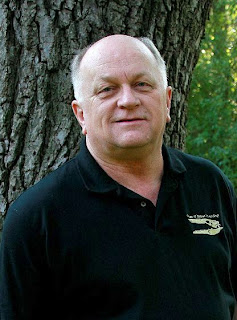 | | Mike Everhart |
One of the resources I used when I was writing CHRONAL ENGINE was Mike Everhart's Oceans of Kansas (Indiana University Press 2005), covering the flora and fauna of the Western Interior Seaway. Michael Everhart is the Curator of Vertebrate Paleontology at the Sternberg Museum of Natural History in Hayes, Kansas. He also maintains the Oceans of Kansas web site. Recently, he graciously agreed to answer a few questions.
1. How did you become/what made you decide to become a paleontologist? Any words of advice to those who might want to pursue such a career?
Being a paleontologist is actually my third career. I worked in the environmental area of public health (12 years) and the aerospace industry (17 years) before becoming a paleontologist. That said, I've always been interested in paleontology and have been collecting fossils from the Smoky Hill Chalk for more than 40 years.
It is a subject that I've been fascinated with from at least the 5th grade when I read a book by Roy Chapman Andrews called "All About Dinosaurs." Actually, the book wasn't all about dinosaurs. There were two chapters describing the marine creatures from western Kansas, mosasaurs, plesiosaurs and pterosaurs. Somehow that stayed with me until I was able to make a trip "out west" during my senior year in college, and I was hooked.  | | Author hard at work. |
The best advice I can give to anyone wanting to become a paleontologist is to study hard in school, especially in the sciences and mathematics. Do well in English because you will need to read and write scientific papers. Paleontology isn't just about going to exotic places and digging up bones. It involves knowing about what you are collecting and being able to describe it to others.
There are two general paths to becoming a paleontologist: geology and biology. You should plan to get either a geology or a biology degree as an undergraduate in college. From there, you can specialize in to different fields of paleontology in graduate school. But on either path, you need to get as much educat
In the 1938 Howard Hawks movie, BRINGING UP BABY, Cary Grant plays a paleontologist with a number of problems: first, he's trying to get ahold of the last piece of his " Brontosaurus" -- the (fictional) "intercostal clavicle" bone. Second, he's trying to solicit a big donation from one of his museum's prime benefactors. Third, he's about to get married. Fourth, he runs across a ditzy heiress played by Katherine Hepburn and who has decided that she wants to marry him (her aunt happens to be the one considering the big donation). Throw in a leopard (actually a jaguar), a dog that runs away with the bone, another jaguar, and a trip to the suburbs, and there's considerable mayhem... I bring this up because a story about the type specimen of T.rex that just came to light. It seems that when the skeleton (the first T.rex ever discovered) was sold by the American Museum of Natural History to the Carnegie Museum in the 1940s, it was missing a piece. This was not discovered until recently, when a rib bone bearing the identification of the Carnegie T.rex was found in storage at the American Museum. So the folks from the American Museum gave it to a guy with a back pack and sent it on its way...No word on whether any leopards were involved. Oh, and apropos of nothing, in the movie NIGHT AT THE MUSEUM, Rexy, the T.rex skeleton, plays fetch with a rib bone. Just saying. Here's a link to the story on NPR.
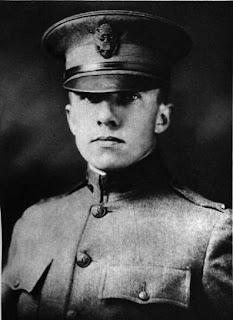 | | Ulysses S. Grant IV (1893-1977) |
This year marks the Sesquicentennial of the Civil War. I've always been fascinated by it and, particularly, by the personalities of the folks who shaped it. I was reading about General of the Army (and, later, President) Ulysses S. Grant the other day when I came across the fact that his grandson, Ulysses S. Grant IV (pictured to the left in 1918), was a paleontologist who specialized in molluscs. This brought to mind two things: (i) Elizabeth Law's pronouncement at the Austin SCBWI conference last February to the effect that "molluscs were the next big thing" in YA literature and that she was awaiting " bivalve love" manuscripts; and (ii) more seriously, my favorite extinct molluscs, the ammonites:  | | Ammonite, HMNS |
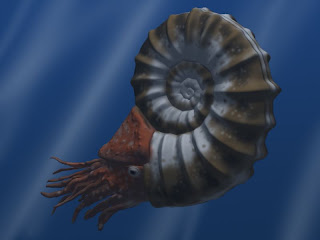 | | Ammonite artist's conception, courtesy Wikipedia |
|
Cephalopods, and therefore related to the octopus and squid, ammonites of the Late Cretaceous variety grew to as much as six feet in diameter. They hung around the middle of the Western Interior Seaway and were preyed upon by mosasaurs. At one point, Grant was curator of invertebrate paleontology at the Natural History Museum of Los Angeles County and also taught paleontology at UCLA. Alas, rather than ammonites (which went extinct at the end of the Cretaceous), Grant appears to have specialized in California molluscs of the Cenozoic. He also apparently appeared on "You Bet Your Life," the show where Groucho Marx always used to ask the question in the title to this post. I kind of wonder how much grief he got -- both as a kid and later as a professional -- because of his name...&nb
When Cyn and I were up in Dallas for BooksmART, we took an afternoon to go see the Dallas Museum of Nature and Science. At the moment, the museum is actually in three buildings, formerly the Museum of Natural History, the Museum of Science, and the Children's Museum, in Fair Park, just across from the Cotton Bowl. A new facility is currently being built in Victory Park. Check out the new digs here.
The dinosaur paleontology exhibits are spread between the Nature Building and the Science Building.
The Science Building has a "Dino Pit," where kids can "dig" for dinosaur bones. Looming above the sand boxes is a T.rex and a Quetzalcoatlus.
 | | Author and pterosaur |
In the room next door are various displays of Alamosaurus bones, as well as other creatures from the Texas Mesozoic. One of the more interesting exhibits is of a bird called Flexomornis howei, discovered in the Woodbine Formation of Texas (about 93-100 million years ago).  | | Author and bird |
Over at the Nature Building, paleontology displays include a Malawisaurus (discovered by researchers from SMU), ammonites and other sea creatures (including the primitive mosasaur Dallasaurus), and Deinosuchus.  | | Greg and Deinosuchus skull |
The basement of the Nature Building houses the prep lab, where paleontologists are presently at work preparing a new Alamosaurus for display. It's my understanding that this Alamosaurus is proof that this genus was a lot larger than previously thought...  1 Comments on Dallas Museum of Nature and Science, last added: 6/13/2011
1 Comments on Dallas Museum of Nature and Science, last added: 6/13/2011
A couple weeks ago, I ran a post about Massachusetts schoolboy Pliny Moody, who dug up dinosaur tracks on his family farm and is credited with the first authenticated dinosaur track discovery in North America. Closer to home, though, dinosaur trackways are known from at least fifty locations throughout Texas. Among the most famous are the trackways in Glen Rose, on a portion of the Paluxy River now part of Dinosaur Valley State Park. The trackways extend over a large area of what was once a coastal plain, on the shores of the Western Interior Seaway. In 1938, Roland T. Bird excavated portions of the tracks, taking them back to the American Museum of Natural History, where they are still on display. Another portion of the trackways is currently housed at the Texas Memorial Museum, where they have been on display in a building outside the museum since 1941. The tracks include those of a sauropod (probably Paluxysaurus, but possibly Sauroposeidon) and a theropod (probably Acrocanthosaurus). The problem is that the building is non-climate-controlled and, apparently, is built on a slab of non-reinforced concrete. This has led to a degradation of the stone the trackways are formed in, which could eventually lead to the complete loss of slab. But plans are afoot to move the trackways indoors, into the Hall of Geology and Paleontology. The museum and the Texas Natural Sciences Center have begun a fundraising campaign to preserve and move the trackways. Go here to check out information on donating to Save the Dinosaur Tracks!
 | | Homo sapiens (foreground) and Tyrannosaurus rex |
This year is the 100th anniversary of the opening of the present building of the National Museum of Natural History (Washington, DC)! (The museum itself officially opened in 1910). Part of the Smithsonian Institution, the National Museum of Natural History has an extensive array of dinosaurs, arranged as part of a chronology of life, from Paleozoic to Cenozoic times.  | | Triceratops |
In addition to tyrannosaurs, the National Museum of Natural History features stegosaurs, diplodocids, ceratopsians, hadrosaurs, as well as a full complement of aquatic reptiles, pterosaurs, and Mesozoic birds. And it's all just down the ramp from the Hope Diamond.  | | Maiasaura juvenile |
 Edmontosaurus in front of mural. Edmontosaurus in front of mural.
A couple years ago, Cyn and I spoke to a class in Michigan at Oakland University and, as part of the research on THE CHRONAL ENGINE, we stopped by the University of Michigan Natural History Museum (Ann Arbor, MI).
This small museum on the campus of the University of Michigan has an entire floor devoted to vertebrate paleontology.
An Allosaurus is on display next to a stegosaurus "carcass," and an Edmontosaurus is laid out before a huge mural showing "now" and "then" scenes of what paleontologists thought and think its life must've been like. You can also get up close to a Deinonychus and an Ankylosaurus tail club, sauropod leg and hip bones, and see various theropod, ornithopod, and sauropod skulls. Looking up, you can also see pterosaurs and a mosasaur.
 Skull of Edmontosaurus Skull of Edmontosaurus
I particularly like the way the displays are laid out. You can get close enough to touch most of them (but you shouldn't :-)) and really get a feel for the size of these creatures, especially the Edmontosaurus, which stretches a good part of the width of the hall.
 Deinonychus Deinonychus
Next time you're in Ann Arbor, check it out!
Happy Independence Day!
It's the 175th anniversary of the signing of the Texas Declaration of Independence, so I thought I'd do a post on big giant lizards in Houston.
 One of the more entertaining aspects of writing novels, in general, and a Cretaceous time-travel novel, in particular, is the research. With THE CHRONAL ENGINE, I had to (re)create an entire ecosystem, which provided an excuse to, among other things, go to zoos and natural history museums. One of the more entertaining aspects of writing novels, in general, and a Cretaceous time-travel novel, in particular, is the research. With THE CHRONAL ENGINE, I had to (re)create an entire ecosystem, which provided an excuse to, among other things, go to zoos and natural history museums.
While (non-avian) dinosaurs are no longer with us, we still have the descendants and/or relatives of many creatures that survived the K-T extinction, including alligators and monitor lizards (and birds, of course). Above, is a photo of me at the Houston Zoo in front of their komodo dragon, the largest monitor lizard. Although its bite is septic, the komodo doesn't really look all that fearsome, particularly behind three-inch glass. Appearances of course can be deceiving, though, and I really wouldn't want to encounter one in the wild.
It's of particular interest to me, though, for a couple reasons: first, monitor lizards are known from the Cretaceous (dinosaurs weren't the only great big scaly things in the ecosystem back then!).
Second, it's related to the mosasaur, the orca-sized (20-30 feet long) aquatic predator from the North American inland sea of the late Cretaceous. Shown below is the Onion Creek mosasaur, on display at the Texas Memorial Museum in Austin:

Below, I'm still at the Houston Zoo, peering at the albino alligator.

Immediately below is a close-up of the animal's forelimb. It's kind of fascinating, how much you can see of the scales on the white animal.

Below, at the Houston Natural Sciences Museum, I'm standing in front of what I believe is a Nile crocodile.
 1 Comments on Texas Independence Day! Big giant lizards!, last added: 3/2/2011
1 Comments on Texas Independence Day! Big giant lizards!, last added: 3/2/2011
 DINOSAUR MOUNTAIN, by Deborah Kogan Ray (FSG 2010). This picture book tells the story of Earl Douglass, bone prospector for the Carnegie Museum of Natural History (who discovered some of that museum's most prized specimens, including Apatosaurus, Diplodocus, Barosaurus, and Camptosaurus) and the creation of Dinosaur National Monument. DINOSAUR MOUNTAIN, by Deborah Kogan Ray (FSG 2010). This picture book tells the story of Earl Douglass, bone prospector for the Carnegie Museum of Natural History (who discovered some of that museum's most prized specimens, including Apatosaurus, Diplodocus, Barosaurus, and Camptosaurus) and the creation of Dinosaur National Monument.
Text is informative and compelling. Sidebar quotes from Douglass's journals and facts about the Mesozoic provide added context. The art elegantly complements the text, showing not only Douglass in action, but also the "tools of the trade," and maps of the Jurassic West. A fine introduction to the "down and dirty" of the Golden Age of dinosaur paleontology.
 Dinosaur Hall, photo courtesy of Houston Natural Sciences Museum Dinosaur Hall, photo courtesy of Houston Natural Sciences Museum
Big news from the Houston Museum of Natural Science (Houston, TX)! They've unearthed a nearly complete, articulated Dimetrodon skeleton, scheduled to go on display in the museum's paleo hall in 2012 (This is a big deal because, despite what you see in museums, paleontologists rarely find nearly whole fossil vertebrates).
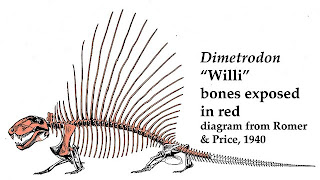
Check out the HNSM blog post here. Oh, and Dimetrodon is a synapsid, not a dinosaur. It's also from the mid-Permian, so predates dinosaurs by about 30 million years. Oddly enough, although it looks like a reptile, it's actually closer to mammals.
Cyn and I took a trip to the the Houston Museum of Natural Science a couple years ago. It's just one museum in the Houston Museum District, near Rice University.
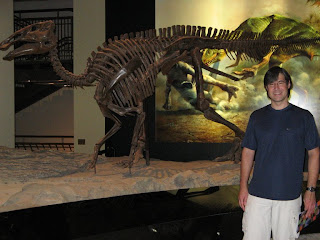 Homo sapiens (foreground) with juvenile Edmontosaurus Homo sapiens (foreground) with juvenile Edmontosaurus
The museum, which is now a century old, has at the center of its Mesozoic display a Tyrannosaurus rex that stalks an adult and juvenile Edmontosaurus. A large sauropod stands aloof from the whole thing, while a Quetzalcoatlus soars overhead (see top photo). A number of smaller "raptors" and birds watch from afar.
 Turtle (Toxochelys, I believe) and Mosasaur Turtle (Toxochelys, I believe) and Mosasaur
The museum also features a number of life re-creations, including an ankylosaur being attacked by a pack of dromaeosaurs. (The ankylosaur, in fact, is the one Sinclair had built for the New York World's Fair. Two others are in Dinosaur Valley State Park in Glen Rose.).
![]()
Last October, I ran a post about the Texas Memorial Museum, UT's natural history museum. But that's not the only place in town for dinosaur-related activity:

The Hartmann Prehistoric Garden (Austin, TX) is an entire garden in Zilker Park devoted to Mesozoic plants that have survived to the present. You can get up close to cycads, gingkos, magnolias, cypresses, dawn redwoods, and more ferns than you can shake a stick at.

The Garden was inspired by the discovery of ornithomimid footprints on the site in the early 90s, so they decided to run with it (pun intended). It's a pretty spectacular experience, beautiful and oddly strange, when you think about the fact that these plants have been around for hundreds of millions of years. Also, the pond you see above has gar and other fish that trace their ancestry back to the Mesozoic, as well.
 And it sits in the shadow of Mopac Expressway. Although you can't see the cars, you can hear them, which makes for an interesting juxtaposition. And it sits in the shadow of Mopac Expressway. Although you can't see the cars, you can hear them, which makes for an interesting juxtaposition.
Right next door is the Austin Nature and Science Center, which has its own Dino-Pit, an outdoor paleontology exhibit where kids can "dig" for their own fossils. They'll "find" casts of fossils from the Pleistocene, the Cretaceous, and the Permian.
Oh, and what's a Sarahsaurus? It's this guy:

It's a sauropodomorph found by University of Texas paleontologist Tim Rowe in Arizona. It's from 190 million years ago (early Jurassic), when dinosaurs were just getting started...And it's named after Sarah Butler, the Austin philanthropist who was instrumental in raising funds for the Dino Pit.
Here's a nice article in the Statesman. And here's a link to a PDF of the official paper, from the
0 Comments on Austin Dinosaurs: Sarahsaurus, the Dino Pit, and the Hartmann Prehistoric Garden as of 1/1/1900
 Thanks, everyone, for all the congratulations and good wishes, here, elsewhere on the Internet, and in person! Looking forward to 2012! Thanks, everyone, for all the congratulations and good wishes, here, elsewhere on the Internet, and in person! Looking forward to 2012!
Note: Above photo is of dunkleosteus, a placoderm (armored fish) from the late Devonian (predated the dinosaurs by millions of years, but it's still really cool-looking.). I like the picture, taken at the University of Michigan Natural History Museum, in part because the reflection makes it look like my head is in the thing's mouth. :-).
A good introduction to the Devonian is here.
|
|








































Who doesn't love dinosaurs? Sounds like a great summer road trip. Thanks for sharing.
Glad you and Cyn took advantage of the detour opportunity:)